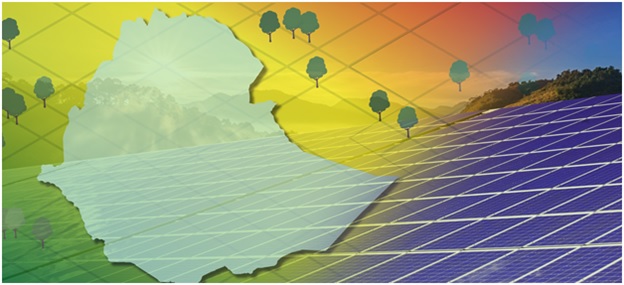Ethiopia has a considerable renewable energy endowment, with an abundant hydropower potential, wind, solar and geothermal, as well fossil fuels. Hydropower constitutes almost 92.5% of the total energy mix and wind energy comprises 7%.
The Ethiopian government hopes to increase the electricity generation capacity of the country from the current 4,400 MW to 17,300 MW by 2025, utilizing hydro, wind, geothermal, solar and waste to energy sources to electrify its industrial base.
In recent years, the emergence of solar power is becoming one of the main power sources. There are two main types of solar power generation: On-grid and off-grid. Currently Ethiopia’s on-grid solar power system is zero MW. However, the government of Ethiopia is working with foreign renewable power developers to produce the first 100MW solar energy project in the town of Metahara, Ethiopia. Since solar irradiance is a suitable method to harness power, using this technology fits in with the long-term vision of Ethiopia’s Electric Power utility company’s (EEP) plan to increase the total power generation capacity to 500MW by 2025.
So far, there are only a few off-grid solar power systems that are supplying regional health centers, telecommunication towers, village well pumps, residential facilities and schools.
On-Grid Solar Power
Solar On-Grid Power Generation schematic
On-grid solar power system is a solar power generation system that is connected to a national power grid maintained by utility companies like EEP. The electricity produced by the system is routed to the grid from where it is used to run the various loads. In an on-grid solar system, the solar power is produced only when the grid is available.
The Direct Current (DC) electricity produced by the solar panels is collected by the combiner and then fed to an inverter to convert the DC voltage to an Alternative Current (AC) voltage of 220V single phase or 380V 3 phase output to be connected to the power grid. The power produced will light up a house or a factory and the excess power is fed via the net metering to the power utility grid.
Most residential homes will be on-grid because this guarantees power whether the solar power system is under or over-produced. With on-grid systems, the solar system sends excess power generated back to the utility grid. These are the most cost-effective and simplest systems to install. This means that the utility system acts as the battery space. With grid-tied systems, the energy you generate is sent into the utility grid. Your panels feed electricity into the grid, which can be distributed to other users in your area.
In return, you receive credit for the energy you generate, which you can use at any time. Think of this as a transaction at the bank: you are allowed to withdraw as much as you deposit. This is what allows you to keep the power on when the sun goes down.
Off-Grid Solar Power
Solar Off-Grid Power Generation schematic
Off-grid means that the power generated by the solar unit is not connected to a national power grid maintained by utility companies such as EEP. Most users find this approach to sourcing power appealing because the user’s energy source is 100% self-sustained, saves money and promotes a greener lifestyle. However, there are some disadvantages because off-grid systems require the user to purchase a back-up battery which can be expensive, bulky, and not environmentally friendly which defeats the purpose of going solar.
An off-grid power source is also known as a stand-alone power system (SAPS). It works by generating electricity from solar panels and using the output to charge a solar battery via a charger controller. That electricity is then converted, using an inverter, so that it can power a home or business load centers. By saving the electricity in a solar battery, it is possible to satisfy power requirements for a home or other facility using solar energy, even at night or during times when there is limited sun exposure. Almost all the solar power generation realized by various organizations in Ethiopia are accomplished via an off-grid connection.
Off-grid systems are different. With no access to the utility grid, batteries become mandatory and you must find another solution to store energy. For that, you’ll need to add a battery bank to your system. Batteries provide dedicated energy storage and backup.
In conclusion, on-grid-tied systems store energy in the power grid, while off-grid systems store energy in batteries. It is imperative that Ethiopia accelerate and harness an on-grid and off-grid solar power system in order to provide essential alternative energy sources.

Engineer Behailu Assefa
Engineer Behailu Assefa is a Managing Director of ASC Engineering Service and Terra Global Energy Developers engaged in the design and implementation of a 400MW wind power project in the Debre Berhan region of Ethiopia. He can be reached at bassefa[at]asceng.net



